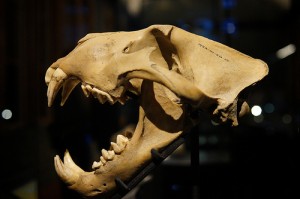Search Results for Tag: scientists
Unraveling a ‘big cat’ DNA mystery
It has all the makings of a historical thriller – scientists in the UK have used the ancient skulls of Barbary lions preserved in the Tower of London to piece together the origin of modern-day big cats. And, they’ve hit upon a vital clue in India which could help resurrect the extinct and majestic Barbary lion of North Africa. First off, what exactly is a Barbary lion? Once found in huge numbers across North Africa, extending from Egypt to Morocco, it had the most spectacular physical features of all lion species. That included an extensive mane, larger body and a more pointed crown and narrow muzzle. Also called the “Atlas lion,” it was reported to have different colored eyes to other lions. Scientists are divided over when and if Barbary lions really went extinct.
The last record of a Barbary lion is an animal shot in Morocco in 1927, though there is circumstantial evidence that Barbary lions may have survived in the wild in the Atlas Mountains till 1942. European zoos have also tended to claim that they have a Barbary lion or two but experts remain skeptical.
Now, a team led by Ross Barnett of Durham University, UK, has discovered that the majestic animal has close genetic links to the Asiatic lions that live in India. (Less than 400 Asiatic lions survive at present on the Kathiawar Peninsula of India and the species is listed as endangered by the International Union for the Conservation of Nature.)
Barnett’s team came to that conclusion after scientists sequenced mitochondrial DNA from museum-held specimens and from Barbary lion skulls discovered preserved in the Tower of London’s moat and believed to date back to the 14th and 15th century. The study was published in the journal BMC Evolutionary Biology. Barnett said he was surprised by the incredibly close relationship between the extinct Barbary lion from North Africa and the Asiatic lion from India. This, he said, could now get conservationists talking about resurrecting the subspecies and reintroducing lions into North Africa. “This has implications for any future attempts to reintroduce lions into North Africa,” Barnett said. “They could probably be re-seeded with Indian lions.” The researchers compared their findings with genetic sequences drawn from other lions living in Asia and across Africa to work out different subspecies of lion evolved. Their work shows that the single species of modern lions’ most recent common ancestor lived around 124,000 years ago.
Scotland’s Marine Atlas
Scotland has put together a marine atlas to chart its biodiversity and help marine planners make development decisions along the country's coast. The Scottish government has made the entire atlas and a variety of information available online, but they also put up this video as a guide.
The atlas helps us understand the state of Scotland's seas. That's important for scientists who want to study marine biodiversity in the region. And the atlas is a kind of manual to help developers understand where they need to be careful of precious sea life–from coral reefs to animals. And last but not least, it helps environmentalists understand the challenges Scotland faces in preserving its biodiversity, too.
Should more countries invest time and research into a marine atlas? How would it benefit the marine life where you life?
Ancient Climate History
Researchers are drilling under the Dead Sea in Israel–almost 800 meters below sea level, to be exact. Why? Scientists are collecting rock samples far underneath the water level because they believe those sediments will be extremely well-preserved, and they could reveal some important clues about earth's history.
The International Continental Scientific Drilling Program (ICDP) includes a team of researchers from around the world, and they think the rocks they find under the Dead Sea will paint a much clearer picture of climate change history in the area around Bethlehem. So far, the workers have already drilled through around half a million years worth of sedimentary rock, which has helped them learn more about earthquake activity in the region.
And what researchers learn in Israel could help them understand more about climate change across the planet. One scientist who's taking part in the drilling mission said the group's findings will have a major impact on science and environment studies, and they could tell us a lot about natural resources in the area.







Feedback